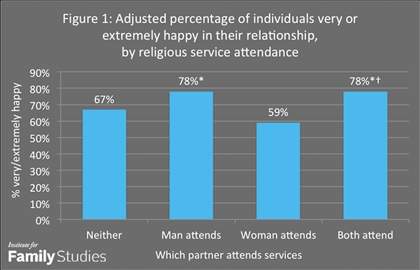 Couples relationship quality higher if both or just man attends services
Couples relationship quality higher if both or just man attends services
From research by The Institute of Family Studies USA
What is the association between regular religious attendance and relationship quality for married and unmarried couples? Religion is most likely to foster better family outcomes when faith is shared, but what is the effect of attending services together (as opposed to by oneself) on relationship quality?
The Institute of Family Studies in the USA analysed survey data and found that religious attendance (across many faiths) is not consistently associated with higher relationship quality among heterosexual couples.
As the graph below shows, if just the woman attends services, the couple is less happy than if he attends alone, both attend, or neither attends religious services regularly.
Men and women in couples where neither partner attends are also less happy than couples where the man attends, either with or without his partner.
78% of men and women in couples who regularly go to services together, or where only the man attends regularly, report that they are “very happy” or “extremely happy,” . By contrast, 67% of men and women in relationships where neither partner attends are happy, and just 59 percent of people in couples where only she attends regularly report they are very happy. Clearly, shared attendance and his attendance are linked to higher self-reported relationship quality.

Why is his solo attendance but not her solo attendance associated with better relationship quality? It might also be that men are likely to benefit from the emphasis that religious institutions tend to put on family life and marital fidelity. In other words, religious services may be effective in turning the hearts and minds of men towards their partner’s welfare and the relationship more generally.
What about joint attendance? Why are couples who go to religious services together happier than those who do not? Two factors seem to be important: sharing friends in a religious congregation and praying together.
Men and women who have more than half of their friends at the same religious congregation are about 11 percentage points more likely to report they are very happy in their relationships than those who do not. Enjoying shared friendships in a religious congregation may boost relationship quality by giving such couples a sense of belonging and community, as well as other models of successful relationships.
Shared prayer is even more strongly associated with higher relationship quality than shared religious service attendance.
Men and women who report praying together frequently (almost once a week or more often) are 17 percentage points more likely to say they are very happy together. Joint prayer is likely to engender a heightened sense of emotional intimacy, communication and reflection about relationship priorities and concerns, and a sense of divine involvement in one’s relationship.
However it works, shared prayer is a stronger predictor of relationship quality than other religious factors. It is also a better predictor of relationship quality than race, education, age, sex, or region. Couples who pray together often are much happier than those who do not.
This research offers two conclusions:
-
Shared religious attendance and a man’s solo attendance are both associated with reporting significantly higher relationship quality.
-
Joint attendance seems to connect men and women to networks of friends who are living family-centered lives, and is also associated with a spiritually intimate behavior. It may well be that the couple that prays together stays together, confirmation of a long-held belief of many churchgoers.
Read the full article here.
Retweet about this article:
From research by The Institute of Family Studies U, 16/01/2017